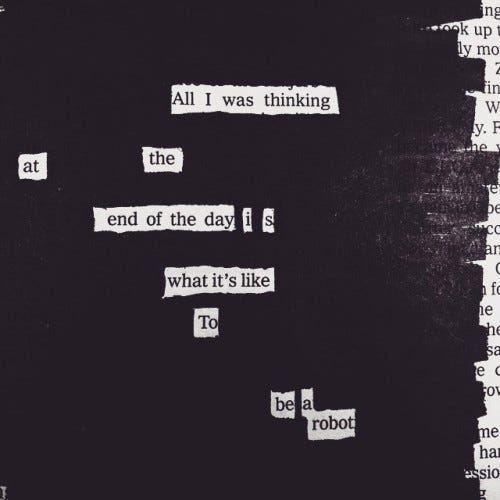
Projecting humanity onto our humanoid machines is an ancient reflex. The earliest automata inspired immediate wonder; some were even pressed into service supplicating the divine. This anthropomorphizing impulse gets more complicated when our automata become sociological facts — machines we talk with, interactive intelligences, algorithms that seek to influence our behavior, cars with personalities. These robots among us, our peer-machines, may not be the best companions or playmates. Perhaps they assert some sort of perverse peer pressure on us: C’mon, kid. Why can’t you keep up with this infinite news stream I curated for you? Look at me! What, don’t trust these amazing shopping choices I went and assembled just for you?! Look at your happy friends!

It’s not entirely their fault. Our uncanny neighbors are on a mission, commanded by their makers. At least for now, the social machines are following orders, enacting their coders’ code. And overwhelmingly, this is the code of commerce and technocentrism. No wonder they’re so awkward at the party. But it needn’t be this way. We can craft a better robot citizenry, one that is informed by our real needs, not just our cookies and consumption whims.
In 1966, scholar Norman Cousins published a piece called “The Poet and the Computer.” Anticipating the computer revolution at his doorstep, Cousins makes a plea: do not allow our machines to dehumanize us. “The danger,” he explains, is “not so much that [we] will be controlled by the computer as that [we] may imitate it.” Intimate and frequent communication with the machines may require us to conform our minds to their limited logics and cold calculations. To preserve and reinforce humanness, Cousins hypothesizes, “…it might be fruitful to effect some sort of junction between the computer technologist and the poet.”
The poet, we may generalize, is the artist, the philosopher and far-sighted historian, the monk, the researcher, the coyote and the clown. Let’s find the means to introduce this cast to our daily digital endeavors as dreamers and makers of the science fiction future. We can find a way to get poetic while honing shopping algorithms and optimizing cloud infrastructure. This way, our nascent AI robots may become fellow travelers rather than the Skynet overlords so regularly predicted by industry leaders and machine ethicists.
The term “robot” originated in a 1921 Czech play called R.U.R., by Karel Čapek. The play is a dystopian tale about factory-assembled replicants who eventually rise and violently replace their human masters. The humans are an easy kill, as they have grown complacent and reliant on their robot servants. The word robot was coined for the play by the playwright’s brother. It is derived from robotnik, the Czech word for forced worker, which itself derives from robotiti, the word for “to work, to drudge.” This was decades before Isaac Asimov would coin robotics and pen his famous Three Laws, crafted to guard against exactly the kind of uprising imagined in R.U.R.

The robot uprising narrative takes on a new twist, however, when we are made robotniks of our robots, drudging through our days serving the algorithms that bind us to each other. Interfaces designed for addiction encourage us to provide the fat data streams that sustain products/experiences/intelligences like Facebook’s machine learning algorithm. How much time do we collectively spend bent at this task and others like it? It seems the robot bully doesn’t want to kill us — it just wants us to conform. In this way, the uprising may already be underway. Incidentally, when you look up R.U.R. on Wikipedia, the first entry in the “See Also” section is “AI takeover.”
Let’s get the poets in the room and build machines that complement our humanity as well as our news feeds and supply chains. Let’s go beyond the information age. Ultimately, we are not creatures of pure information. The robots are. Sapiens refers to wisdom and, as Cousins cautioned half a century ago:
The question persists and indeed grows whether the computer makes it easier or harder for human beings to know who they really are, to identify their real problems, to respond more fully to beauty, to place adequate value on life, and to make their world safer than it is now. The reason these matters are important in a computerized age is that there may be a tendency to mistake data for wisdom.
Clearly, we’re off to a strong start on the computer front; now is the perfect time to invite the poet. There are no doubt countless ways to achieve Cousins’s junction between the arts and humanities and the technologists. Our aim is to devise a framework for doing so, one that is easily enacted and sustainable for large organizations and individuals alike. And we’ve got one: it’s called The Alchemy of Wasted Time, and it encourages an approach to innovation that includes pondering the corpus of our arts and humanities, copious low-stakes prototyping, and a healthy dose of daydreaming.
Stay tuned for Part II: The Alchemy of Wasted Time…
